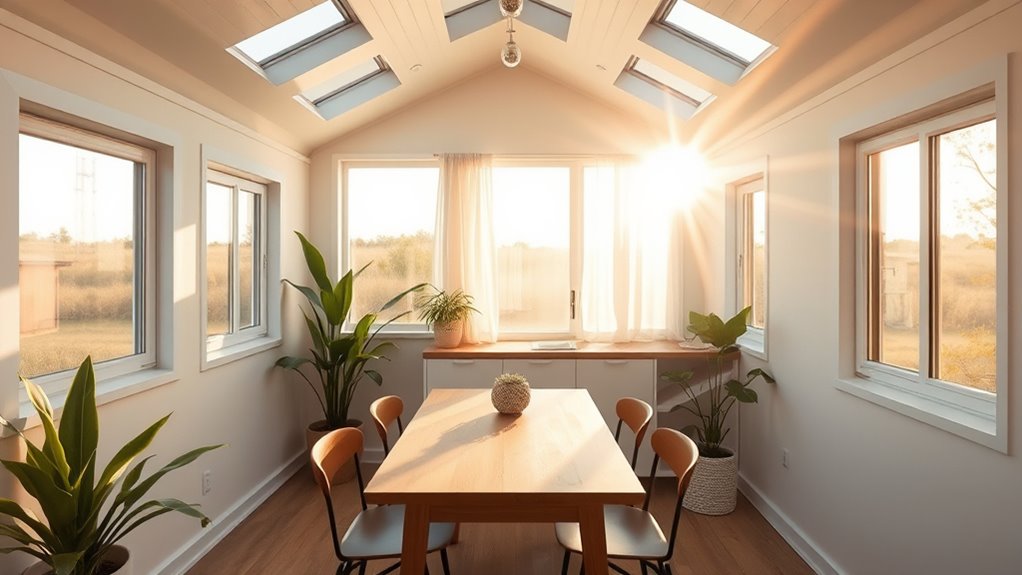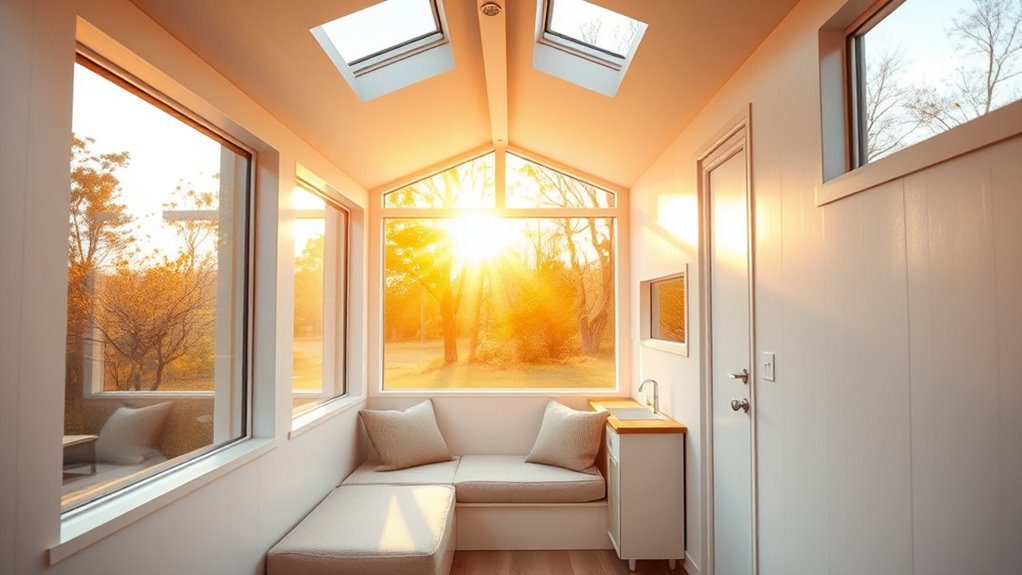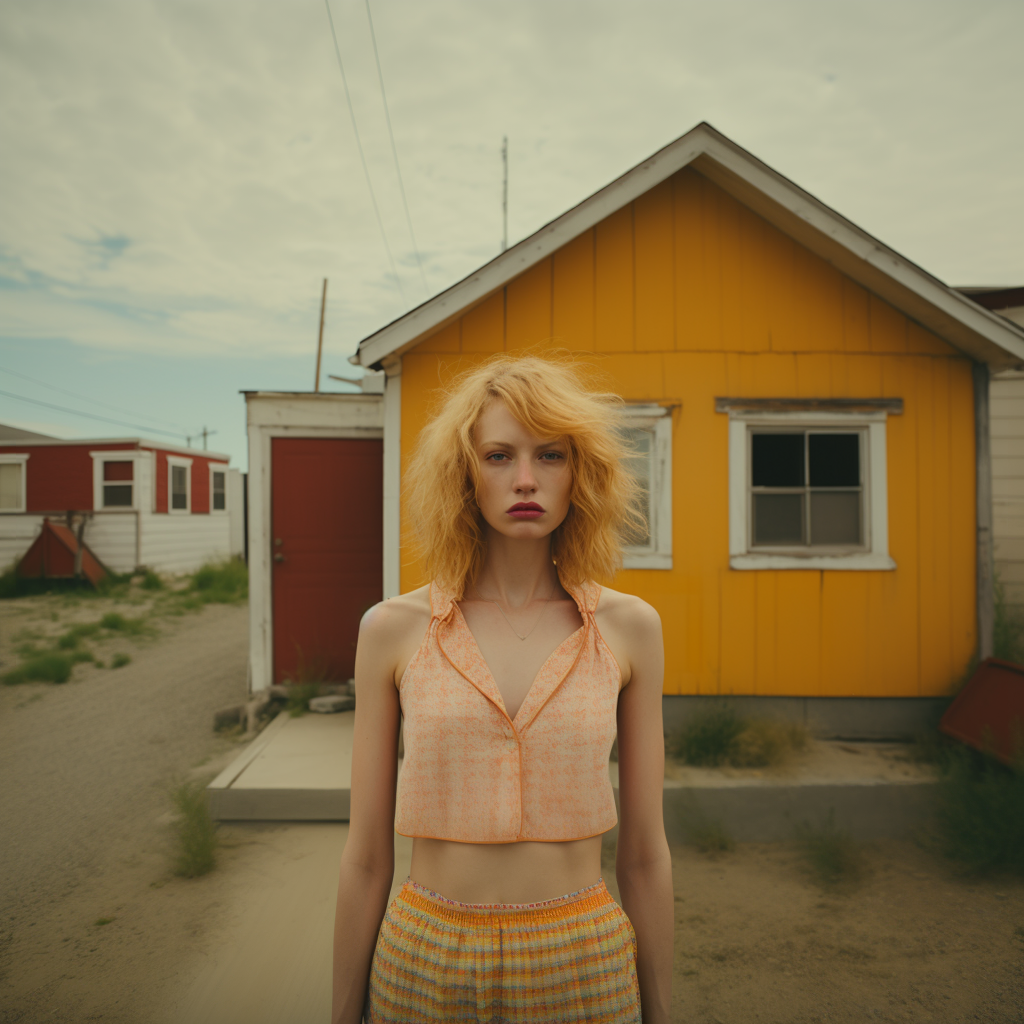Imagine waking up in a tiny house where sunlight floods in through carefully placed windows, making the space feel open and inviting. Achieving this kind of brightness isn’t accidental; it requires thoughtful design choices that maximize natural light. From window placement to interior colors, the right tactics can transform a small space into a luminous retreat. Curious about which strategies truly work and how to implement them effectively?
Key Takeaways
- Use large south-facing windows and skylights to increase daylight entry in small spaces.
- Select light-colored interior palettes and reflective surfaces to amplify natural light reflection.
- Incorporate outdoor privacy screens like lattice panels or tall plants to block neighbors while allowing sunlight.
- strategically place windows and barriers to optimize light flow and prevent obstructions.
- Combine exterior privacy solutions with interior design to create a bright, private, and inviting tiny home.

Maximizing natural light in tiny houses can dramatically enhance your living space, making it feel larger, more inviting, and more energy-efficient. When you focus on how light interacts with your interior, you create a bright, airy environment that feels anything but cramped. One of the most effective ways to do this is by choosing the right interior color schemes. Light, neutral tones like whites, creams, and soft pastels reflect sunlight throughout your space, reducing the need for artificial lighting during the day. These colors also help create a seamless flow, making small rooms appear more expansive. You can add visual interest with subtle accents in bolder hues, but keeping the primary palette light ensures sunlight bounces around freely. Additionally, selecting reflective surfaces such as glossy tiles, glass, or high-gloss paint can further amplify natural light.
Light, neutral colors and reflective surfaces maximize natural sunlight in tiny houses, making spaces feel larger and more inviting.
Beyond interior choices, outdoor privacy solutions play a pivotal role in maximizing sunlight without compromising your privacy. Installing strategic outdoor privacy screens, lattice panels, or tall plants can block neighboring views while still allowing sunlight to filter into your windows. These solutions let you enjoy the benefits of open, sunlit spaces without feeling exposed. For example, a well-placed wooden lattice or a row of tall shrubs can act as a barrier, shielding your windows from direct line of sight while letting light pass through. This setup encourages more sunlight to reach your interiors and reduces the need for window coverings that may block or diffuse light.
Another tactic is the thoughtful placement of windows and skylights. Positioning larger windows on the south side of your tiny house maximizes exposure to sunlight during the day. Skylights are especially effective in small spaces because they can illuminate areas that might otherwise stay dark. To optimize their impact, consider window treatments that allow you to control light levels—such as adjustable blinds or sheer curtains—so you can enjoy sunlight when desired and reduce glare or heat gain when needed. Incorporating energy-efficient window designs can further optimize light intake while maintaining thermal comfort.
Combining these design tactics creates a harmonious balance. Your interior color schemes reflect and amplify natural light, while outdoor privacy solutions ensure your space remains cozy and secluded. Together, they transform your tiny house into a bright, welcoming retreat that feels much larger than its actual size. With intentional choices, you gain a luminous, inviting environment that’s energy-efficient and perfectly tailored to your lifestyle.
Conclusion
By applying these design tactics, you’ll turn your tiny house into a bright, inviting haven that feels much larger than it is. Strategic window placement, light colors, and reflective surfaces work together to flood your space with natural light. Remember, a well-lit home isn’t just about aesthetics; it’s about creating an environment where you feel energized and at ease. When it comes to maximizing light, you’re really on the right track—just don’t forget to keep your eyes open for new ideas along the way.
Hi, I’m Emma. I’m the Editor in Chief of Tiny House 43, a blog all about tiny houses. While tree houses are often associated with childhood, they can be the perfect adult retreat. They offer a cozy space to relax and unwind, surrounded by nature. And since they’re typically built on stilts or raised platforms, they offer stunning views that traditional homes simply can’t match. If you’re looking for a unique and romantic getaway, a tree house tiny house might just be the perfect option.










